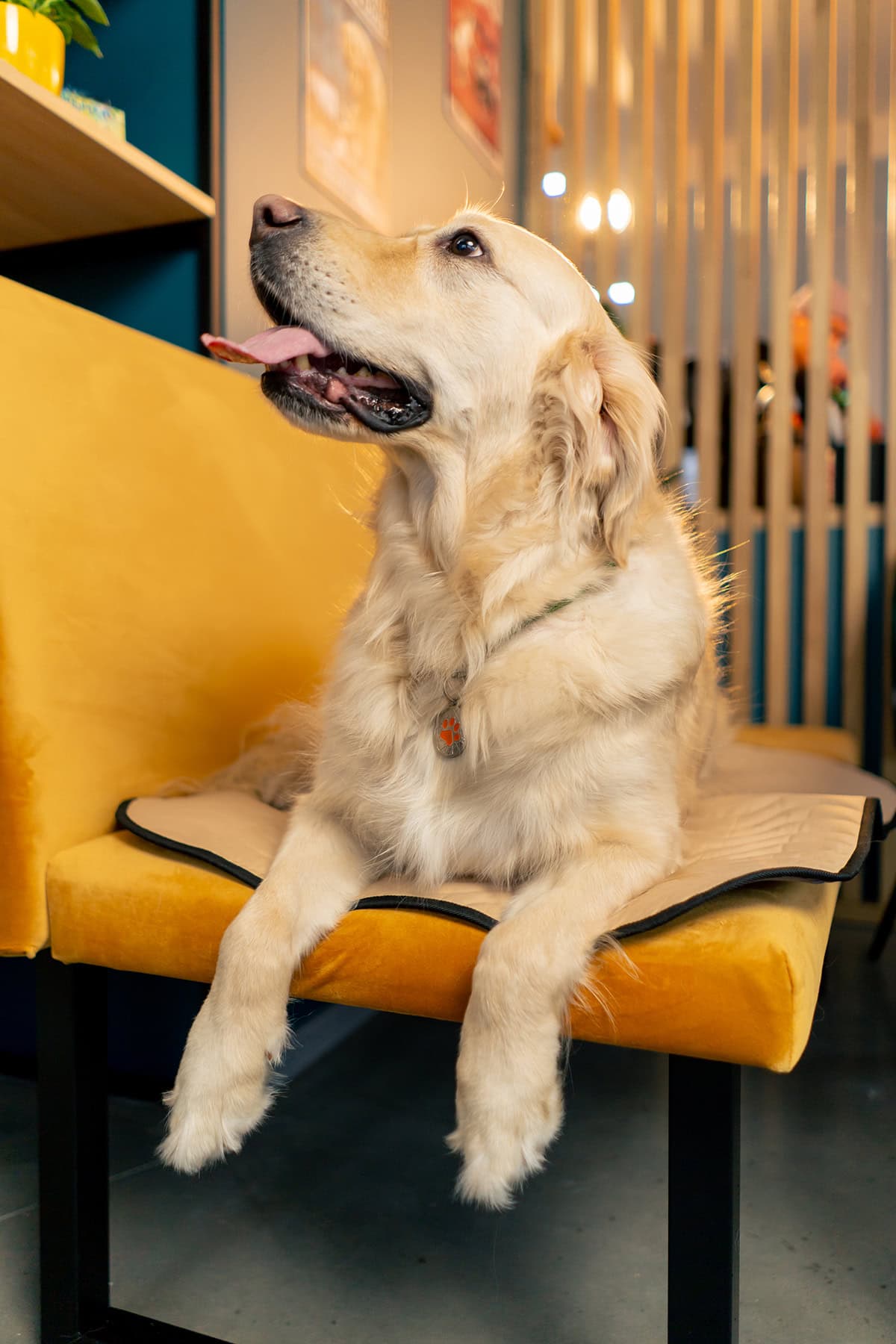Best Ways to Prevent Dogs from Peeing on Furniture
-
 By
Ava Thompson
By
Ava Thompson

Is your dog peeing on the furniture? In this guide, we’ll be explaining why it happens and how you can prevent it with some proven strategies.
Table of Contents
ToggleUnderstanding Why Dogs Pee on Furniture
Various factors, including marking behavior, pet health, and emotional triggers, can cause a dog to pee on furniture. Knowing these reasons will allow you to address the root cause.
Urine Marking Behavior
Urine marking is a common behavior, especially in intact male dogs, and is their way of asserting territory.
Unlike submissive urination, which is triggered by excitement or fear, marking is a deliberate act of claiming a space.
Hormones also play a significant role in marking behavior, which is why neutering may help.
Health Issues

Health issues can also lead to inappropriate urination, with conditions like urinary tract infections, incontinence, and dementia being common culprits.
Some signs that your dog may have a urinary tract problem include increased thirst, frequent urination, and blood in the urine.
Other medical conditions, such as kidney disease, diabetes, adrenal gland issues, and arthritis, can also affect a dog’s ability to urinate properly.
Emotional Factors
Emotional factors such as separation anxiety, excitement, fear, and submission can also cause a dog to urinate on furniture.
Submissive urination, on the other hand, often occurs during greetings or play due to a lack of confidence in the dog.
Dogs that exhibit submissive urination are often shy or anxious.
In cases like that, using gradual exposure paired with positive reinforcement can help build their confidence.
Preventing Your Dog From Peeing on Furniture
Establishing a consistent routine and cleaning schedule can help maintain a fresh-smelling home and prevent dogs from being attracted to previously soiled areas.
For one thing, you want to thoroughly clean previously soiled areas, ideally with an enzyme cleaner; that will prevent your dog from being attracted to the same spot.
House Training Refresher

A house training refresher can work wonders for dogs that have forgotten their manners.
This means regularly taking your dog outside, especially after eating, playing, or waking up.
You also want to maintain a consistent feeding schedule; that will help establish a routine for bathroom breaks.
Enrolling in training classes can also help by providing a structured learning environment to help your dog overcome these types of behavior.
Restrict Access to Furniture
You can limit a dog’s access to furniture by using physical barriers such as gates, crates, or other obstacles. Installing pet gates or baby gates will also help limit their movement and prevent them from accessing furniture during training.
Use an Enzymatic Cleaner
Enzymatic cleaners are essential for removing urine odors. Unlike regular cleaners, they are able to break down the compounds in urine, preventing dogs from remarking the area. Not only that but they will completely eliminate the urine smell.
For the best results, we recommend using ACTIVE Pet Odor & Stain Eliminator Spray. Simply spray it onto the problem area, wait, then blot with a clean cloth. Not only is it great for furniture but it can also be used on other surfaces as well such as carpet, upholstery, and hard floors.

Managing Incontinence in Senior Dogs
Symptoms of urinary incontinence include leaking or dribbling urine sporadically, as well as leaving urine puddles. While the issue is often seen in seniors, it can also occur in young adults.
In cases like that, you can use doggie diapers or belly bands to prevent messes. You can also place absorbent pads in areas where they frequently urinate to protect furniture and flooring.
Behavioral Solutions for Emotional Peeing
As mentioned earlier, emotional factors can also lead to inappropriate urination. Here are a few ways to deal with these issues.
Reducing Separation Anxiety
Desensitization training is one of the best ways to help a dog with anxiety-related urination. You can also give your dog engaging chew toys or puzzle toys to help manage their anxiety when they are left alone.
Hiring a local pet sitter or dog walker is another solution.
Building Confidence
Using positive reinforcement, such as treats or praise, can enhance the effectiveness of your training efforts. Remember, patience is key.
Creating a Pee-Free Environment
Regular Cleaning Routine

Maintaining a consistent cleaning schedule will help eliminate the scent of dog urine in the house, making it less likely for dogs to soil the same areas.
Any accidents should also be cleaned up immediately with an enzyme-based product, such as the one by ACTIVE.
Using Puppy Pads and Dog Beds
Placing puppy pads in designated areas will help provide a controlled space for dogs to relieve themselves.
Providing them with a comfortable dog bed will also encourage them to rest in the designated areas, reducing the likelihood of accidents on furniture.
Getting Professional Help
Consulting an Animal Behaviorist
If your adult dog still pees on furniture despite training, you may need help from a professional. An animal behaviorist will be able to provide tailored strategies to address the dog’s persistent behavioral issues.
Dog Pees On Furniture – Overview
Inappropriate urination can be caused by various things from behavioral issues to health conditions (e.g. urinary tract infection). Understanding the root cause will allow you to implement the best strategy on how to help your pup.
Not only that but it’s also important to maintain a clean environment in the house, and don’t hesitate to seek professional help if necessary.
With persistence and the right strategies, you will be able to keep your furniture clean and your dog happy.
Key Takeaways
- Understanding the reasons behind your dog’s urination, including health and emotional factors, is essential to addressing the behavior
- Preventive measures such as routine training, using barriers, and cleaning with enzymatic cleaners can significantly reduce the chance of dogs peeing on furniture
- Consulting a veterinarian or animal behaviorist can help provide tailored strategies to address underlying medical or emotional issues
Understanding a Dog’s Marking Behavior – FAQs
Why does my house trained dog pee on furniture?
Your dog might be peeing on furniture as a way to mark territory, or it could be a sign of health issues or anxiety. It’s important to observe their behavior and consult a vet if it continues.
How can I reduce urine marking in dogs?
To stop your dog from peeing on furniture, consider giving them a refresher course on house training, restricting their access to the furniture, and cleaning any spots with ACTIVE Pet Odor & Stain Eliminator Spray to remove odors.
Should I consult a vet if my dog keeps peeing in the house?
Yes, it’s a good idea to consult with a vet if your dog keeps peeing on furniture. It could be a sign of a medical problem that needs attention.
Can senior dogs develop urinary incontinence?
Yes, it’s not uncommon for senior dogs to develop urinary incontinence, but the good news is that it can be managed effectively with options like doggie diapers and veterinary support.
15% Off Amazon Coupon
×Click To Reveal The 15% Off Coupon Code For Your Entire ACTIVE Purchase At Amazon.com
Note: This promotional offer is only guaranteed through the end of the day.




